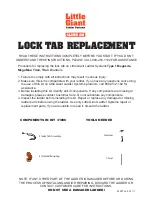
GSSIM Mini Scaffolding Assembly & Operating Instructions
7
f. Apply pulling or pushing forces at the bottom frames and as close to the scaffold base as possible.
Never attempt to move scaffold from on top.
g. If rolling scaffolds are used outdoors, care must be taken to assure that they cannot become
unstable due to wind or other conditions.
P. DO NOT OVERLOAD SCAFFOLD
. Refer to and do not exceed the scaffold load capacities.
Post these scaffolding safety guidelines in a place where it will be seen and understood by all persons
who erect, dismantle or use scaffolding.
Be certain all persons are aware of the correct installation of scaffold, the potential dangers, and discuss
this in safety meetings.
Since field conditions vary and are beyond the control of the SSFI and the SIA, safe and proper use of
scaffolding is the sole responsibility of the user
CODE OF SAFE PRACTICES FOR FRAME SCAFFOLDS, SYSTEM SCAFFOLDS,
TUBE & CLAMP SCAFFOLDS & ROLLING SCAFFOLDS
Developed by the Scaffold Industry Association, Inc. (SIA) and the Scaffold, Shoring & Forming Institute (SSFI)
It shall be the responsibility of all users to read and comply with the following common sense guidelines which are designed to promote safety in the
erecting, dismantling and use of Scaffolds. These guidelines do not purport to be all-inclusive nor to supplant or replace other additional safety and
precautionary measures to cover usual or unusual conditions. If these guidelines in any way conflict with any state, local, provincial, federal or other
government statue or regulation, said statute or regulation shall supersede these guidelines and it shall be the responsibility of each user to comply
therewith.
I. General Guidelines
A.
Post these scaffolding safety guidelines in a conspicuous place and be sure that all persons who erect, dismantle or use scaffolding are aware
of them, and also use them in tool box safety meetings.
B.
Follow all state, local and federal codes, ordinances and regulations pertaining to scaffolding.
C.
Survey the job site. A survey shall be made of the job site by a competent person for hazards, such as untamped earth fills, ditches, debris,
high tension wires, unguarded openings, and other hazardous conditions created by other trades. These conditions should be corrected or
avoided as noted in the following sections.
D.
Inspect all equipment before using. Never use any equipment that is damaged or defective in any way. Mark it or tag it as defective. Remove it
from the job site.
E.
Scaffolds must be erected in accordance with design and/or manufacturer’s recommendations.
F.
Do not erect, dismantle or alter a scaffold unless under the supervision of a competent person.
G.
Do not abuse or misuse the scaffold equipment.
H.
Erected scaffolds should be continually inspected by users to be sure that they are maintained in safe condition. Report any unsafe condition
to your supervisor.
I.
Never take chances! If in doubt regarding the safety or use of the scaffolds, consult your scaffold supplier.
J.
Never use equipment for purposes or in ways for which it was not intended.
K.
Do not work on scaffolds if your physical condition is such that you feel dizzy or unsteady in any way.
L.
Do not work under the influence of alcohol or illegal drugs.
II. Guidelines For Erection And Use Of Scaffolds:
A.
Scaffold base must be set on base plates and an adequate sill or pad to prevent slipping or sinking and fixed thereto where required. Any part
of a building or structure used to support the scaffold shall be capable of supporting the maximum intended load to be applied
B.
Use adjusting screws or other approved methods to adjust to uneven grade conditions.
C.
Bracing, leveling and plumbing of frame scaffolds.
1. Plumb and level all scaffolds as erection proceeds. Do not force frames or braces to fit. Level the scaffold until proper fit can be easily
made.
2. Each frame per panel shall be braced by horizontal bracing, cross bracing, diagonal bracing, or any combination thereof for securing
vertical members together laterally. All brace connections shall be made secure, in accordance with the manufactures recommendations.
D.
Bracing, leveling and plumbing of tube and clamp system scaffolds.
1. Posts shall be erected plumb in all directions, with the first level of runners and bearers positioned as close to the base as feasible. The
distance between bearers and runners shall not exceed manufacturer’s recommendations.
2. Plumb and level all scaffolds as erection proceeds.
3. Fasten all couplers and/or connections securely before assembly of next level.
4. Vertical and/or horizontal diagonal bracing must be installed according to manufacturer’s recommendations.
E.
When free standing scaffold towers exceed a height of four (4) times their minimum base dimension, they must be restrained from tipping.
(CAL/OSHA and some government agencies require stricter ration of 3 to 1.)















